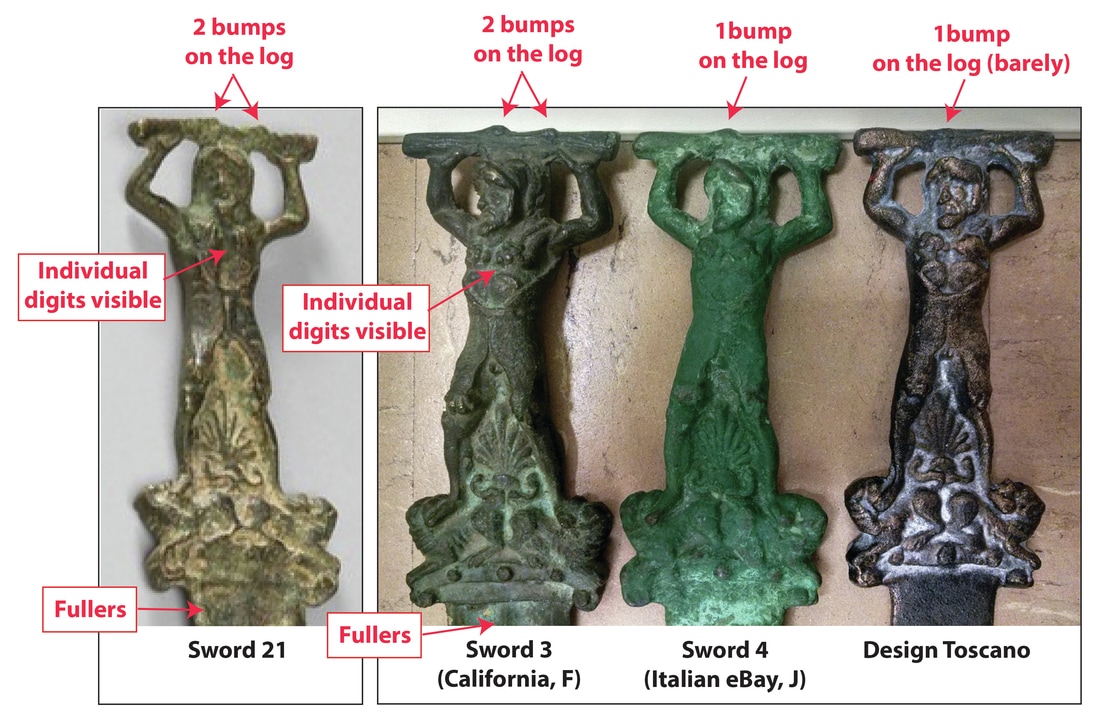A comment by Graham on yesterday's blog post about the newly-discovered Sword 21 raised the possibility that Sword 21, with it's fullered/ribbed "xiphos" blade was a member of the parent generation to the Type F swords (California [Sword 3] and Sonja [Sword 8]):
"Interesting. That design with the full length rib running down the center of the blade looks like the 'fullers' on the California and Sonja blades. Could one of these 'daggers' have been broken in two near the hilt and then used to cast those blades."
I think that's a reasonable working hypothesis.
One mystery that it would explain is the origin of the partially-fullered blade on the F swords . . . those swords have fullers that begin at the guard but end just a few centimeters down the blade.
The hypothesis that Sword 21 is a representative of a pre-F generation of swords raises several expectations. As I discussed in this post from last January, we can presume that successive generations of swords will be smaller and less detailed. Loss of both size and detail would have been the expected results of the process of making successive new molds from swords. If Sword 21 is earlier than Sword 3 (the Type F sword about which we have the most detailed information), we would expect the hilt to be larger and at least as detailed as Sword 3.
Unfortunately, we have only a single photograph of Sword 21. It isn't scaled, so we can't say anything about size. Comparison of the Sword 21 hilt with those of other generations of swords does seem to me to be consistent with the idea that it is early in the copy chain.
- Log Bumps: The two pronounced bumps visible on the top of the log are important, as the California sword also has them but they are absent in later generations. The J and CS versions have a single pronounced bump; the Design Toscano version has a very muted bump.
- Lion Paw Digits: The individual digits of the paws of Hercules' lion skin are visible on Sword 21. They're also visible in the California sword. They're less discernible on the J swords; by the time you get to the Design Toscano swords the lion's paws are just blobs.
- Fullers: As Graham pointed out, if you chop off the blade of Sword 21 near the hilt, you've got a blade segment that appears from the photograph to be more-or-less identical with the fullered blades of the Type F swords. The fullers are lost completely in later generations as the blades become shorter and cruder.
I didn't fully appreciate the possible significance of Sword 21 when I first looked at the image -- I thought maybe it was a bizarre side-branch. But now I think it could be closer to the root. I wish we had some better pictures of the thing. I wonder if it would be worth following up with the auction site to see if they know anything else about the sword (perhaps even who purchased it).
I'm looking forward to seeing what my fellow Swordgate fans think of the idea that Sword 21 gets us closer to the elusive Mother of All Fake Hercules Swords. My plan today is to take the kids to the beach. Hopefully you guys can solve the mystery while I'm looking for shark teeth.



 RSS Feed
RSS Feed
